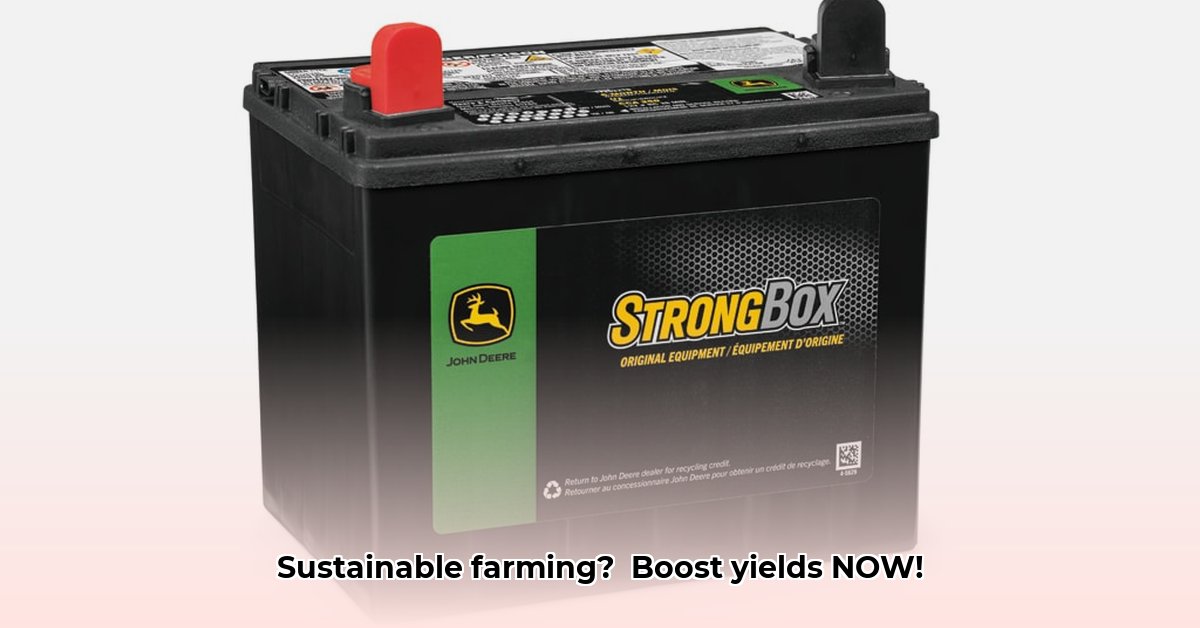
Running a sustainable farm requires careful management of resources and costs. Fuel prices fluctuate, and environmentally friendly solutions are often more expensive upfront. But what if a surprisingly affordable and eco-friendly solution already exists? Tractor Supply's marine batteries offer a surprisingly versatile option for powering your farm sustainably. This guide details how to leverage these durable batteries to reduce your carbon footprint and boost efficiency. For more information on compatible chargers, check out Tractor Supply chargers.
Beyond the Boat: Innovative Uses of Marine Batteries on Your Farm
Tractor Supply's deep-cycle marine batteries are designed for consistent power delivery over extended periods. This makes them ideal for various farm applications, moving beyond their traditional use in boats. These readily available batteries can significantly contribute to sustainable farming practices.
Electrifying Your Farm: Actionable Applications
Electric Fencing: Eliminate environmentally unfriendly chemicals in traditional fence energizers. Marine batteries offer a safe and eco-friendly alternative, ensuring livestock containment while minimizing environmental impact. This method offers a consistent power supply crucial for reliable fencing.
Irrigation: Replace noisy and polluting gas generators with quiet electric pumps powered by marine batteries. This not only contributes to a more peaceful farm environment but enables precision watering, reducing water waste and conserving this precious resource. Electric pumps can be controlled to water precisely where needed, optimizing water use.
Remote Monitoring: Power remote sensors and monitoring systems off-grid by using marine batteries. This constant power supply facilitates continuous data collection, crucial for informed decision-making and yield optimization. Continuous data allows you to react quickly to changes in crop conditions.
Electric Farm Vehicles: While full electrification of farm vehicles is still emerging, marine batteries can power smaller electric utility vehicles around your farm. This contributes to cleaner air and a healthier environment. Small steps towards electrification accumulate over time to create a significant difference.
Choosing and Maintaining Your Marine Batteries: A Practical Guide
Selecting the right battery is crucial for optimal performance and longevity. Consider these key factors:
Amp-hour (Ah) Rating: This signifies the battery's capacity (how long it can power a device). A higher Ah rating indicates longer operation before recharging.
Voltage: Most systems operate on 12 volts, but some might require 24 or 48 volts (requiring multiple batteries in series).
Reserve Capacity: This indicates how long the battery can supply a 25-amp current before voltage drops significantly. A higher reserve capacity means greater reliability and lifespan.
Consult Tractor Supply experts for personalized recommendations. They can help you determine the optimal battery configuration for your specific needs and applications. Don't hesitate to ask questions – informed decision-making is key to success.
A Step-by-Step Installation and Maintenance Plan
Secure Connections: Ensure all connections are secure and properly grounded to prevent damage. Loose connections can lead to power losses and potential hazards.
Charge Controller: Use an appropriate charge controller to prevent overcharging and maximize battery lifespan. This prevents damaging the batteries and ensures their longevity.
Regular Inspections: Periodically inspect terminals for corrosion and clean as needed. Corrosion diminishes efficiency and can eventually lead to failure.
Voltage Monitoring: Monitor battery voltage regularly to ensure consistent charging. Low voltage indicates potential issues that need addressing.
Battery Monitoring System: Consider investing in a battery monitoring system for precise tracking of battery health and performance. This proactive approach helps prevent unexpected failures.
Scheduled Replacement: Replace batteries according to the manufacturer's recommendations. This prevents unexpected downtime and ensures the consistent operation of your systems.
Consistent maintenance optimizes battery lifespan and reduces long-term costs.
Pros and Cons: A Realistic Assessment
| Pros | Cons |
|---|---|
| Reliable power for various farm needs | Requires regular maintenance and charging |
| Cost-effective compared to some alternatives | Higher initial investment than some fuel options |
| Environmentally friendly, reduced carbon footprint | Limited lifespan compared to some newer technologies |
| Readily available at Tractor Supply | Requires adaptation for specific applications |
Troubleshooting Common Problems: Solutions at Your Fingertips
Battery Not Charging: Check connections, charging system, and alternator for faults. A faulty component can prevent the battery from charging correctly.
Low Battery Voltage: Test for parasitic drain (a continuous current draw even when the system is off), indicating a short circuit. This can quickly drain the battery.
Shorter-Than-Expected Lifespan: Incorrect charging, extreme temperatures, or frequent deep discharges reduce battery lifespan. Following correct procedures can significantly increase the life of your batteries.
This guide serves as a general overview. Always consult with agricultural professionals or Tractor Supply experts for tailored advice. The transition to sustainable energy sources involves a learning curve, but the long-term benefits are worth the effort.